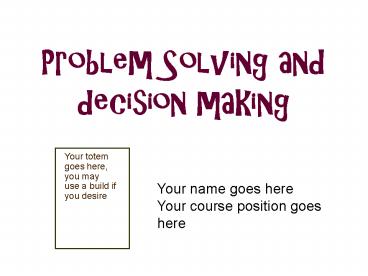Problem Solving and decision making - PowerPoint PPT Presentation
1 / 19
Title:
Problem Solving and decision making
Description:
Your totem goes here, you may use a build if you desire Your name goes here Your course position goes here LEARNING OBJECTIVES As a result of this session, you will ... – PowerPoint PPT presentation
Number of Views:1257
Avg rating:3.0/5.0
Title: Problem Solving and decision making
1
Problem Solving and decision making
Your name goes here Your course position goes here
2
LEARNING OBJECTIVES
- As a result of this session, you will be able to
- Analyze a problem and submit it to a systematic
problem-solving process. - Understand the relationship between problem
solving and project management. - Put into action many of the skills and ideas
learned during the Wood Badge course. - Prepare yourselves for the upcoming Problem
Solving Round-Robin.
3
FIVE STEPS OF TEAM-BASED PROJECT PLANNING
- Project overview
- Work breakdown structure
- Activity assignments
- Action on the plan
- Closeout report
4
PROJECT PLANNING PROBLEMS
- Within the context of a larger project.
- Independent of the project.
5
FIVE STEPS OF SYSTEMATIC PROBLEM SOLVING
- Describe the problem.
- Gather information.
- Determine the most important factors that
contribute to the problem. - Visualize what success looks like.
- Create action steps that will lead to that
success.
6
FIVE STEPS OF SYSTEMATIC PROBLEM SOLVING
- Describe the problem.
- Accurately
- Completely
7
FIVE STEPS OF SYSTEMATIC PROBLEM SOLVING
- 2. Gather information.
- quantitative
- (facts that can be measured)
- qualitative
- (how people feel about situation)
8
FIVE STEPS OF SYSTEMATIC PROBLEM SOLVING
- Determine the most important factors
- that contribute to the problem.
- Timing
- Personnel
- Setting
- Any combination of all three
9
FIVE STEPS OF SYSTEMATIC PROBLEM SOLVING
- Visualize what success looks like.
- Describe how things will be when the
- problem is solved and everything is
- working well.
10
FIVE STEPS OF SYSTEMATIC PROBLEM SOLVING
- 5. Create action steps that will lead to that
success. - Close gap between current situation
- and visualization of success.
11
ADVANTAGES OF SYSTEMATICALLY SOLVING PROBLEMS
- Time-saver.
- Teams solve problems more quickly efficiently.
- Increases the odds of success.
12
MAKING DECISIONS
- Brainstorming
- Consensus
- Multi-Voting
- Parking Lot
13
MAKING DECISIONS
- Brainstorming
- Encourage everyone to participate.
- Think outside the box.
- Piggyback ideas.
- Consider how similar problems have been solved in
the past.
14
MAKING DECISIONS
- Consensus
- Team works in atmosphere of trust and agrees to
abide by group agreement. - Possible solutions assessed evaluated to see if
they fit vision of success. - Give consensus decision a trial run before
finalizing it.
15
MAKING DECISIONS
- Multi-Voting
- Each team member has an equal number of votes.
- If sorting list, members rank items if reducing
list, members cast out poorest choices. - Cast votes, total scores, repeat if necessary.
16
MAKING DECISIONS
- Parking Lot
- Acknowledge that issue is not immediately
relevant. - Write brief description of issue for discussion
at later time.
17
LEARNING OBJECTIVES
- As a result of this session, you should now be
able to - Analyze a problem and submit it to a systematic
problem-solving process. - Understand the relationship between problem
solving and project management. - Put into action many of the skills and ideas
learned during the Wood Badge course. - Prepare for the upcoming Problem Solving
Round-Robin.
18
Thank You!
19
GROUP ISSUES FOR PROBLEM SOLVING ROUND-ROBIN
20
Change control log Change control log Change control log Change control log
Date Version Changes By
Jan. 14, 2009 0.1 template Fred M. Stringer































